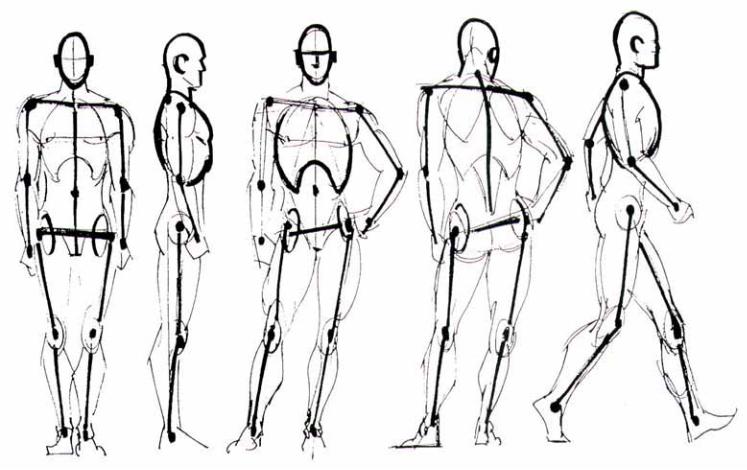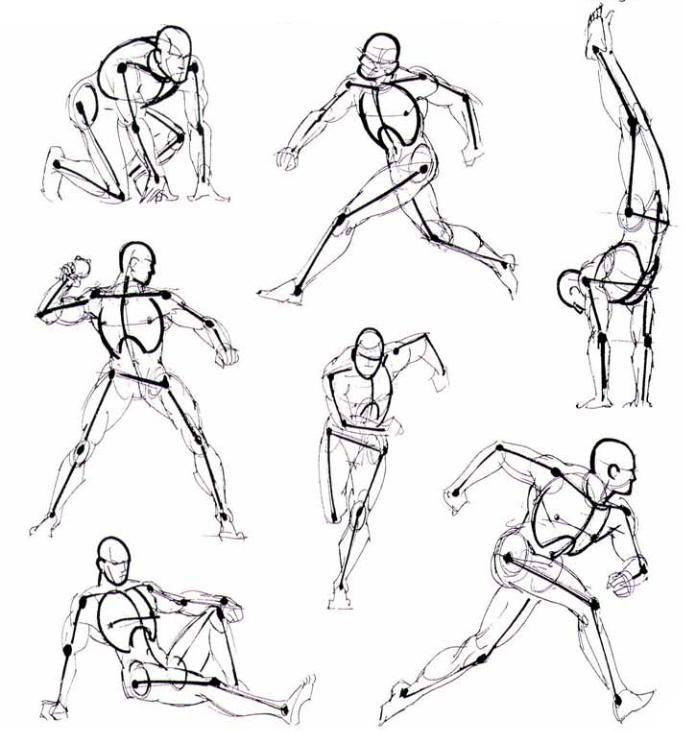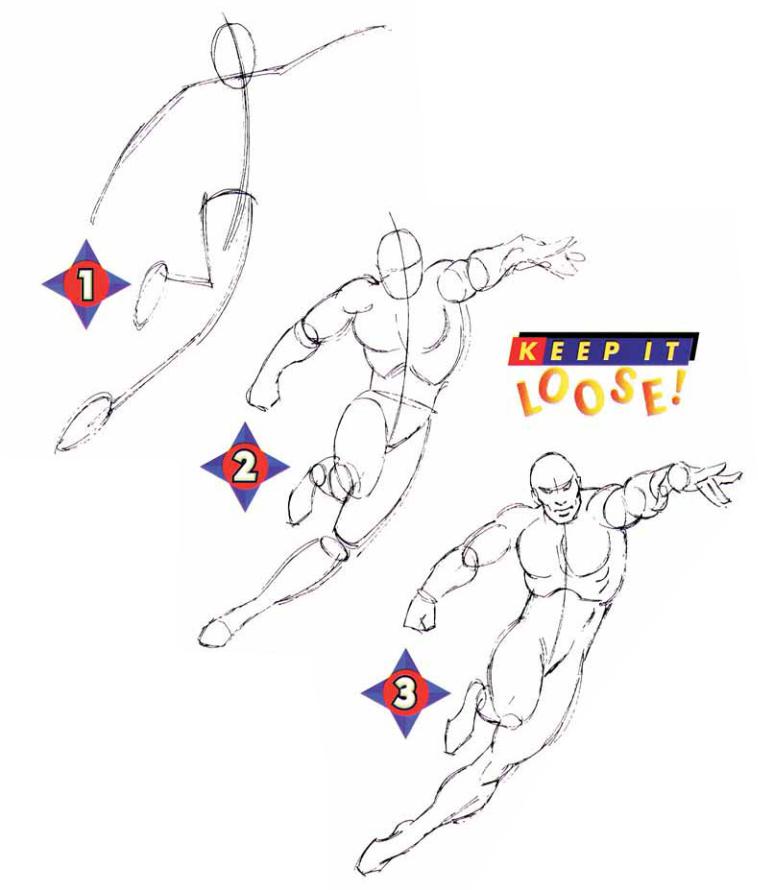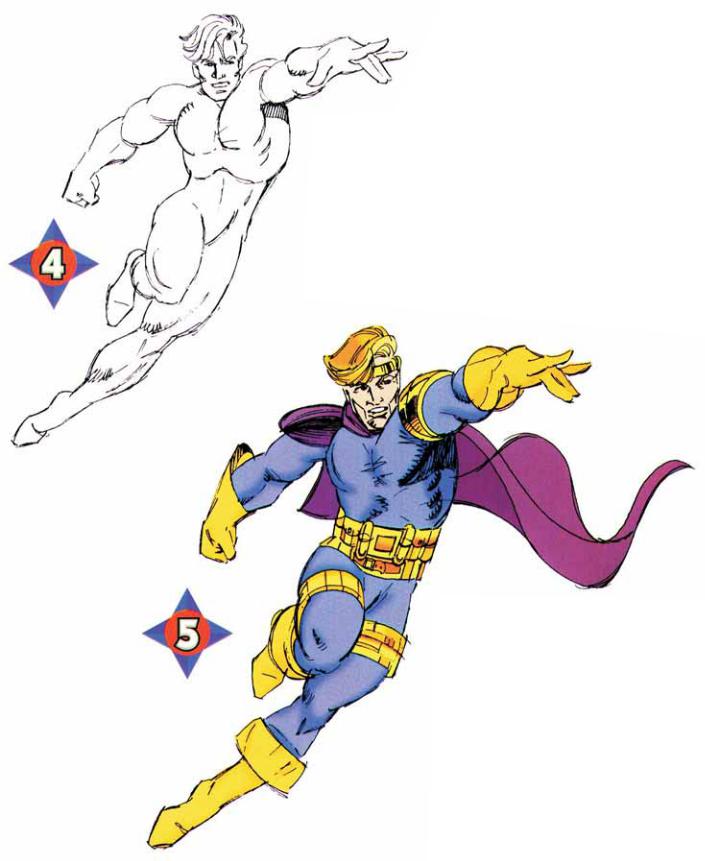
- •Acknowledgments
- •Contents
- •Introduction
- •The Contributing Artists
- •Sketching Different Head Shapes
- •Facial Features
- •How to Draw Hair
- •Popular Comic Book Expressions
- •Grimaces
- •Anatomical Proportions
- •Body Basics
- •Building an Action Pose
- •The Action Figure, Step By Step
- •The Heroic Female Figure
- •Anatomy of the Hand
- •Basic Hand Poses
- •Heroic Hands
- •Female Hands
- •Turnarounds
- •Devastating Punches
- •Clean Punches
- •The Lunge Attack
- •Leaning Into the Punch or Kick
- •The Judo Shoulder Throw
- •David vs. Goliath
- •The Balance of Power
- •The Renegade Soldier
- •Sword-and-Sorcery Villains
- •Forces of Evil
- •Inventing a Villain
- •Beastly Villains
- •Hollywood Heavies
- •Dressed to Kill
- •Unearthly Creatures
- •Comic Book Beauties Then...
- •Femme Fatales Yesterday...
- •...And Today
- •Denizen of the Street
- •Beauty in All Shapes and Colors
- •Drawing from Photos
- •Good Gal Heroes
- •Strong But Sexy
- •A Hint About Skintight Costumes
- •One-Point Perspective
- •Two-Point Perspective
- •The Horizon Line and the Figure
- •Multiple Figures in Perspective
- •Hanging Figures on a Horizontal Line
- •Creating Volume with Perspective
- •Dynamic Angles
- •From Start to Finish
- •Using Pattern and Value
- •Special Effects in Space
- •Bursts
- •Putting It All Together
- •Effective Composition
- •The Establishing Shot
- •What a Comic Book Script Looks Like
- •Thumbnail Sketches
- •The Rough Layout
- •Preparing a Pencil Layout for Inking
- •The Final Inked Page
- •Inking Like a Pro
- •Stuff You Need to Know
- •Art Supplies Shopping List
- •Reflections
- •Light Source
- •Shading
- •Varying An Ink Line
- •Folds and Drapery
- •Designing Costumes
- •Rapid Fire
- •In The Crosshairs
- •Hidden Danger
- •Aggressive Assault Vehicles
- •Off-Road
- •Mean Machines
- •Sky Patrol
- •Fighter Planes
- •How Things are Supposed To Get Done
- •How to Get Your First Job
- •Interview With A Noted Comic Book Editor and Publisher

BODY BASICS
Look at the basic lines of the body. All its forces are working in harmony. The thick, black lines
indicate the position of the major bones, which serve as the foundation for every pose. You can see the weight and mass of the rib cage, the curve and direction of the spine, and the width of the pelvis.
Note that the collarbone is wide, like a ledge, which lays the foundation for a massive chest. The shoulder blades add width to the back. This visual shorthand provides the framework on which the finished drawing is hung. All of your figure drawings should begin with this underlying framework.

BUILDING AN ACTION POSE
Comic book heroes and villains are made to move, jump, leap, and soar. But when you start
to position your figure in dynamic poses, things can get tricky-unless you've taken care to maintain its essential building blocks. This is done by taking a moment to sketch out a solid rib cage, collar bone, pelvis, and the other major bones before executing the finished drawing.
Contrary to what your instincts might tell you, muscles alone do not make a character appear
sturdy. Solid bone structure does. That's because all muscles are attached to bones, so unless you have a solid foundation of bones, those muscles will appear rubbery. But that doesn't mean that you must
render a skeleton in painstaking detail. It can be done quickly, in a sketchy shorthand, as in these fine examples. While it's true that you'll erase many of these preliminary steps when you do the final "clean" version of your hero, your drawings will benefit immeasurably from them.

THE ACTION FIGURE, STEP BY STEP
N ow let's apply what we've learned, taking it step by step,
and finish with a detailed figure. Most pros start with the second step, because the first step has become second nature. But no pro starts with the precision of the fifth step. They always sketch roughly first. After you've gotten the hang of it, you'll begin at the second step, too.
Start with a simple line drawing. Keep it loose. Try to feel the flow and energy of the pose.
Sketch the large muscles and areas first. If a form has two sections, like an arm, sketch each section separately: first the upper arm, then the forearm. Sketch the upper leg, then the lower leg. Sketch the rib cage separately from the waist and so on.
Continue to define the form in this way. This will give your drawing more authority.

Now start to smooth out the figure by erasing the construction lines. The care you've taken with the underlying framework has paid off in a solidlooking figure. Draw the hands and feet in detail, and begin to indicate some shading possibilities.
Suit your character up in an eyecatching outfit and work out the details. The pros always add the fine points last. The beginner typically focuses on the details of the costume and tries to draw them early on, but keep in mind that the figure always suffers as a result.
